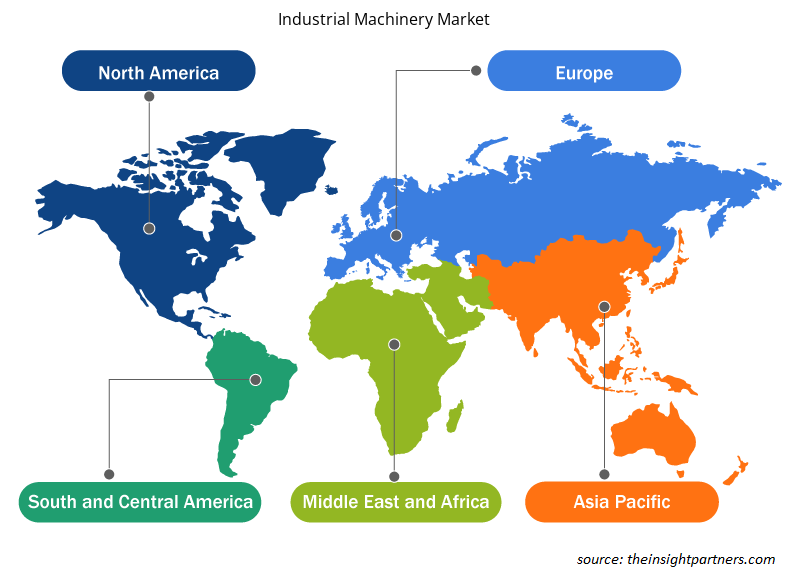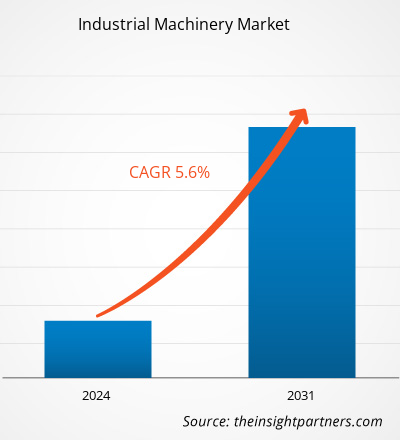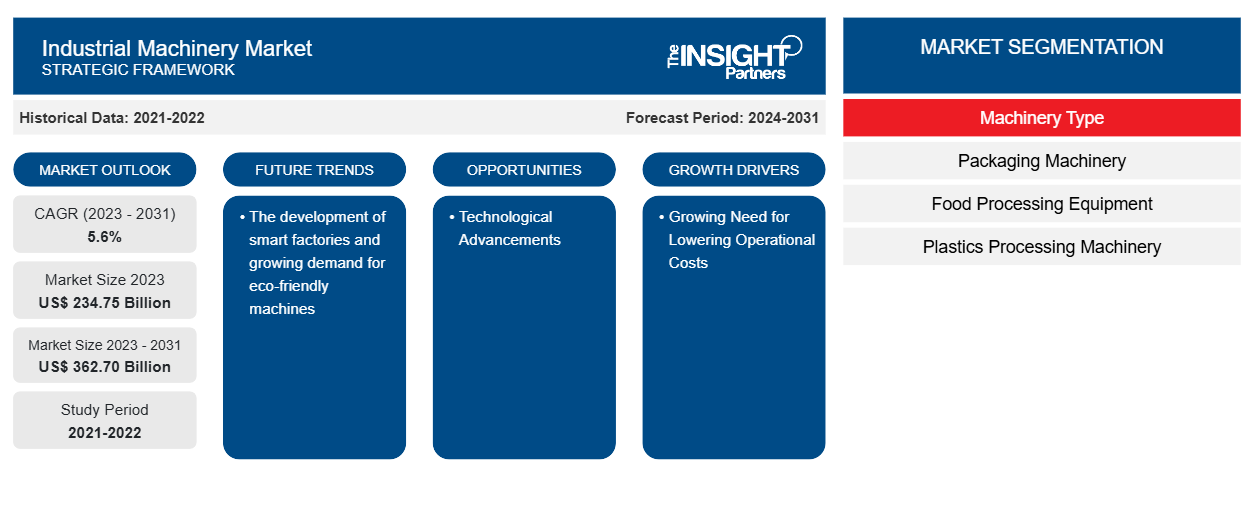산업 기계 시장 규모는 2023년 2,347억 5,000만 달러에서 2031년 3,627억 달러로 성장할 것으로 예상됩니다. 이 시장은 2023~2031년에 5.6%의 CAGR을 기록할 것으로 예상됩니다. 스마트 팩토리의 개발과 친환경 기계에 대한 수요 증가는 주요 산업 기계 시장 추세로 남을 가능성이 높습니다.
산업 기계 시장 분석
산업용 기계 시장은 운영 비용 절감에 대한 필요성이 커지고 자동차, 식품 및 음료, 제약, 제조 및 기타 산업에서 산업용 기계 채택이 증가함에 따라 빠른 속도로 성장하고 있습니다. 시장은 도시화 및 산업 자동화 의 증가로 인해 꾸준히 확장되고 있습니다 . 게다가 기술 발전과 AI 및 3D 디지털 인쇄 기술의 통합은 시장 성장을 위한 수익성 있는 기회를 제공하고 있습니다.
산업 기계 시장 개요
산업용 기계는 주어진 기능을 수행하고 특정 결과를 생성하도록 설계 및 사용되는 모든 기계, 전기 또는 전자 장비를 말합니다. 제조 공장의 제조업체는 이러한 기계를 절단, 성형, 성형, 적층 또는 생산 공정 조정에 사용합니다. 산업용 기계는 전 세계적으로 산업 활동을 지원하는 데 중요한 역할을 합니다. 증가하는 디지털화, 기술 발전 및 Industry 4.0 이니셔티브는 시장에서 기회를 창출하고 있습니다.
귀하의 요구 사항에 맞게 이 보고서를 사용자 정의하세요
이 보고서의 일부 또는 국가 수준 분석, Excel 데이터 팩을 포함하여 모든 보고서에 대한 사용자 정의를 무료로 받을 수 있으며 신생 기업 및 대학을 위한 훌륭한 혜택과 할인 혜택을 이용할 수 있습니다.
-
이 보고서의 주요 시장 동향을 알아보세요.이 무료 샘플에는 시장 동향부터 추정 및 예측까지 다양한 데이터 분석이 포함됩니다.
산업 기계 시장 동인 및 기회
운영 비용 절감에 대한 요구 증가로 시장이 성장하고 있습니다.
운영 비용이 낮으면 마진이 높아져 기업은 제품 제공을 다양화하고 비용 절감 이니셔티브를 통해 새로운 시장에 진출할 수 있습니다. 기업에서 운영 비용을 낮춰야 한다는 요구가 커지면서 기술적으로 진보된 기계에 대한 수요가 증가합니다. 제조업체는 원격 모니터링, 중앙 피드백 시스템 및 기타 기능과 같은 향상된 서비스를 제공하기 위해 이러한 장치에 IoT 애플리케이션을 통합하고 있습니다. 게다가 제조업체는 전반적인 비즈니스 비용을 낮춰 운영 프로세스를 간소화하기 위해 향상된 센서, 모바일 앱 및 임베디드 소프트웨어를 채택하고 있으며, 이는 시장을 주도하고 있습니다.
기술 발전 - 산업 기계 시장의 기회
예측 기간 동안 산업 기계 시장에서 혁신을 주도할 것으로 예상되는 급속한 기술 발전이 있습니다. 또한 제조 산업은 운영 비용을 줄이고 생산성을 개선하며 더 높은 수익을 얻기 위해 인공 지능, 3D 프린팅, 빅 데이터 분석과 같은 첨단 기술을 채택하고 있습니다. 그러나 3D 프린팅과 AI 기술의 잠재적 통합은 산업 기계 시장에 있는 국제 및 국내 기업 모두에게 성장 기회를 창출하고 있습니다.
산업 기계 시장 보고서 세분화 분석
산업 기계 시장 분석에 기여한 주요 부문은 기계 유형입니다.
- 산업기계 시장은 기계 유형에 따라 포장기계, 식품 가공 장비, 플라스틱 가공 기계, 금속 성형 공작 기계, 목공 기계로 구분됩니다.
- 포장 기계 세그먼트는 충진 기계, 팔레타이징 기계, 라벨링 기계, 포장 기계 등으로 세분화됩니다. 식품 가공 장비 세그먼트는 슬라이서 및 다이서, 압출 장비, 디포지터 및 믹서, 보관 및 냉장 장비 등으로 세분화됩니다. 플라스틱 가공 기계 세그먼트는 검사 성형 기계, 블로우 성형 기계, 압출 성형 기계 등으로 세분화됩니다. 금속 성형 공작 기계 세그먼트는 압력 기계, 굽힘 기계, 주조 기계, 펀칭 기계 등으로 세분화됩니다. 목공 기계 세그먼트는 선반 기계, 연삭 기계, 밴드톱 기계 등으로 세분화됩니다.
지역별 산업 기계 시장 점유율 분석
산업 기계 시장 보고서의 지리적 범위는 주로 북미, 아시아 태평양, 유럽, 중동 및 아프리카, 남미/남중미의 5개 지역으로 나뉩니다.
수익 측면에서 아시아 태평양 지역은 교통, 에너지, 도시 개발과 같은 인프라 프로젝트에 대한 투자가 증가함에 따라 가장 큰 산업 기계 시장 점유율을 차지했습니다. 건설 기계, 토목 장비, 자재 취급 장비와 같은 다양한 산업 장비에 대한 수요가 증가하면서 이 지역의 시장이 활성화되고 있습니다.
산업 기계 시장 지역 통찰력
Insight Partners의 분석가들은 예측 기간 동안 산업 기계 시장에 영향을 미치는 지역적 추세와 요인을 철저히 설명했습니다. 이 섹션에서는 북미, 유럽, 아시아 태평양, 중동 및 아프리카, 남미 및 중미의 산업 기계 시장 세그먼트와 지리에 대해서도 설명합니다.

- 산업 기계 시장에 대한 지역별 특정 데이터를 얻으세요
산업 기계 시장 보고서 범위
| 보고서 속성 | 세부 |
|---|---|
| 2023년 시장 규모 | 2,347억 5천만 달러 |
| 2031년까지 시장 규모 | 3627억 달러 |
| 글로벌 CAGR (2023-2031) | 5.6% |
| 역사적 데이터 | 2021-2022 |
| 예측 기간 | 2024-2031 |
| 다루는 세그먼트 |
기계 유형별
|
| 포함된 지역 및 국가 |
북아메리카
|
| 시장 선도 기업 및 주요 회사 프로필 |
|
산업 기계 시장 참여자 밀도: 비즈니스 역학에 미치는 영향 이해
산업용 기계 시장은 소비자 선호도의 변화, 기술 발전, 제품의 이점에 대한 인식 증가와 같은 요인으로 인해 최종 사용자 수요가 증가함에 따라 빠르게 성장하고 있습니다. 수요가 증가함에 따라 기업은 제품을 확장하고, 소비자의 요구를 충족하기 위해 혁신하고, 새로운 트렌드를 활용하여 시장 성장을 더욱 촉진하고 있습니다.
시장 참여자 밀도는 특정 시장이나 산업 내에서 운영되는 회사나 기업의 분포를 말합니다. 주어진 시장 공간에 얼마나 많은 경쟁자(시장 참여자)가 존재하는지 그 규모나 총 시장 가치에 비해 나타냅니다.
산업 기계 시장에서 운영되는 주요 회사는 다음과 같습니다.
- AB 일렉트로룩스
- 알파라발
- 아마다 주식회사
- GEA그룹
- 아이티안 인터내셔널
- 미쓰비시 중공업 주식회사
면책 조항 : 위에 나열된 회사는 어떤 특별한 순서에 따라 순위가 매겨지지 않았습니다.

- 산업 기계 시장의 주요 기업 개요를 알아보세요
산업 기계 시장 뉴스 및 최근 개발
산업 기계 시장은 1차 및 2차 조사 이후의 정성적, 정량적 데이터를 수집하여 평가하는데, 여기에는 중요한 기업 간행물, 협회 데이터, 데이터베이스가 포함됩니다. 다음은 산업 기계 시장과 전략의 개발 목록입니다.
- 2022년 11월, Ingersoll Rand는 산업용 135MAX Heavy Duty Air Hammer를 출시했습니다. 135MAX HD Air Hammer는 119MAX가 구축한 기반을 바탕으로 저렴한 가격으로 놀라운 성능과 파워를 제공하는 차세대 에어 해머입니다. 전설적인 Ingersoll Rand 임팩트 렌치에서 영감을 받은 미세 조정된 깃털 트리거를 활용하여 더 정밀하고 더 나은 결과를 얻을 수 있습니다. (출처: Ingersoll Rand, 보도 자료, 2022)
산업 기계 시장 보고서 범위 및 제공물
"산업 기계 시장 규모 및 예측(2021-2031)" 보고서는 아래 영역을 포괄하는 시장에 대한 자세한 분석을 제공합니다.
- 범위에 포함된 모든 주요 시장 세그먼트에 대한 글로벌, 지역 및 국가 수준의 시장 규모 및 예측
- 동인, 제약 및 주요 기회와 같은 시장 역학
- 주요 미래 트렌드
- 자세한 PEST/포터의 5가지 힘과 SWOT 분석
- 주요 시장 동향, 주요 업체, 규정 및 최근 시장 동향을 포괄하는 글로벌 및 지역 시장 분석
- 시장 집중도, 히트맵 분석, 유명 기업 및 최근 개발 사항을 포함하는 산업 환경 및 경쟁 분석
- 자세한 회사 프로필
- 과거 분석(2년), 기준 연도, CAGR을 포함한 예측(7년)
- PEST 및 SWOT 분석
- 시장 규모 가치/거래량 - 글로벌, 지역, 국가
- 산업 및 경쟁 환경
- Excel 데이터세트
최근 보고서
사용 후기
구매 이유
- 정보에 기반한 의사 결정
- 시장 역학 이해
- 경쟁 분석
- 고객 인사이트
- 시장 예측
- 위험 완화
- 전략 기획
- 투자 타당성 분석
- 신흥 시장 파악
- 마케팅 전략 강화
- 운영 효율성 향상
- 규제 동향에 발맞춰 대응























 무료 샘플 받기 - 산업 기계 시장
무료 샘플 받기 - 산업 기계 시장